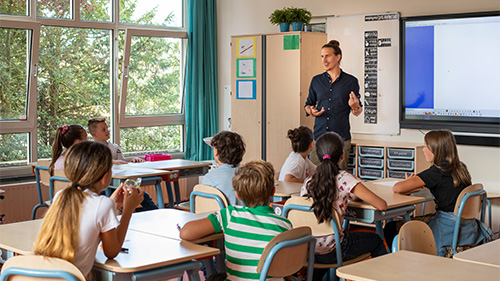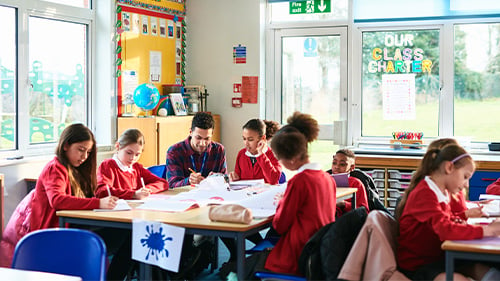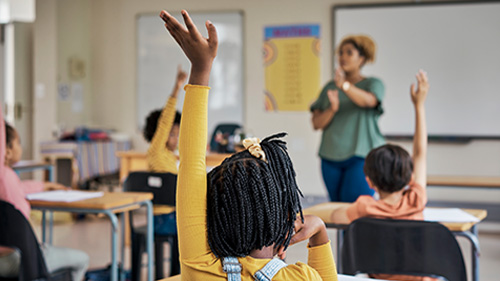Summer Learning Narrows the Achievement Gap
Summer is almost here. For many, it’s a time to relax and leave schoolwork worries behind. However, by the time school starts up again in the fall,...
AP & Honors Mathematics
Explore Wiley titles to support both AP and Honors mathematics instruction.
Literacy Skills & Intensive Reading
Connections: Reading – Grades 6–12
Empower student success with a proven intensive reading program that develops strong reading skills in striving readers.
Drama, Speech & Debate
Basic Drama Projects 10th Edition
Build students’ confidence and competence with comprehensive, project-based theatre instruction.
Literature
Connections: Literature
Support learners as they study dynamic, relevant texts and bring the richness of diverse voices to students through literature.
Literature & Thought
Develop critical thinking, reading, and writing across literacy themes, genres, historical eras, and current events.
Language Arts
Vocabu-Lit® – Grades 6–12
Help students build word power using high-quality contemporary and classic literature, nonfiction, essays, and more.
Connections: Writing & Language
Help students develop grammar, usage, mechanics, vocabulary, spelling, and writing and editing skills.
Reading/English Language Arts
Measuring Up to the English Language Arts Standards
Incorporate standards-driven teaching strategies to complement your ELA curriculum.
English Language Learners
Measuring Up for English Language Learners
Incorporate research-based best practices for ELLs with an approach that includes a focus on language acquisition strategies.
Mathematics
Measuring Up to the Mathematics Standards
Incorporate standards-driven teaching strategies to complement your mathematics curriculum.
Foundations
Measuring Up Foundations
Help students master foundational math skills that are critical for students to find academic success.
Science
Measuring Up to the Next Generation Science Standards
Give students comprehensive NGSS coverage while targeting instruction and providing rigorous standards practice.
Assessment
Measuring Up Live
Deliver innovative assessment and practice technology designed to offer data-driven instructional support.
For a better website experience, please confirm you are in:
2 min read
Measuring Up Jan 27, 2025 8:00:00 AM

As an educator, there might be one question you dread above all others: “But when am I ever going to use this?”
For many students, understanding how classroom curriculum applies to the real world is notoriously difficult. In areas like English and Mathematics, many students fall into the trap of regurgitating information without really comprehending the underlying framework. To successfully understand and apply these concepts, students must be able to think critically about a subject matter area and draw conclusions about its importance and application.
Generating positive results on end-of-year tests is a function of helping students make real-world connections between what they are being taught in the classroom, and how those ideas frequently impact their own life.
Research conducted by famous educator Edward Dale showed that when students are able to apply curriculum to authentic experiences, knowledge retention skyrockets to over 90%.[1] This is 18x more effective than when they simply listen to teachers or watch a lecture.
Mastery Education, the developers of Measuring Up, created new state-specific, print instructional materials, that utilize real-world connections to support knowledge retention. Learning objectives are tied into existing background knowledge, which encourages students to focus on real-world connections and applications. This creates a better opportunity for students to internalize the information.
If you are interested in applying this methodology in your classroom, here are 5 tips that support a real-world connection philosophy.
Students want to know why something is important to learn. Providing tools for students that help them grasp how the fundamental concepts they are learning will be relevant later on is crucial. Integrating technology with subjects like math can engage students and prove the legitimacy of what they are learning.
Students are more likely to retain information if it reflects patterns and statistics they find in their own life. “Research on culturally relevant and responsible instruction clearly shows that knowledge of students’ family, community and socioethnic cultures—their languages, literacy practices, and values—can help teachers address the interests and build on the skills of their students” (p. 254)[2]
One school with a significant population of ESL students challenged their Spanish class to create a helpful video that would help new students learn more about the school and culture.[3] This project not only challenged students to use correct grammar and learn new words, but it created a context for how learning a new language could help them build lasting relationships.
Using current political and popular issues and news is one way to create a lasting impression with learners. These areas often spark passionate debates that resonate much more than antiquated or abstract examples.
The significant interest in entrepreneurship in the United States has created an opportunity for teachers to show how fundamental concepts can enable innovation. When students are tasked with creating products they care about, they are more likely to see how professions like engineering, business, and finance require a solid education.
Sources:
[1] http://blogs.edweek.org/edweek/education_futures/2017/03/creating_real-world_connections_and_fostering_college_and_career_readiness.html
[2] https://education.ucf.edu/mirc/docs/pp/FLaRE%20Professional%20Paper%20-%20Culturally%20Competent%20Literacy%20Instruction.pdf
[3] http://www.ascd.org/publications/books/102112/chapters/Making_a_Real-World_Connection.aspx

Summer is almost here. For many, it’s a time to relax and leave schoolwork worries behind. However, by the time school starts up again in the fall,...

Spring is in the air, and school children all across the nation are entering the last leg of the academic year. But before the final bell rings, many...

National Dropout Prevention Center’s evaluation of Measuring Up reveals students experienced substantial academic progress

An exit ticket can be an effective way to determine if students are understanding what they are being taught. They provide immediate feedback, while...

As a public educator, one of the most vital things that I try to get my students to understand is how all the information they learn works together...

Every spring, standardized testing can feel like a looming mountain for both students and teachers. The challenge is real: how do we prepare students...

December is a unique month in the classroom. Energy is high, schedules are unpredictable, and instructional time can feel fragmented. But it’s also...

Every time I open up Instagram, Facebook, or Twitter, I’m given the option to post to stories or urged to open the stories of others. Pictures that...

Having a comprehensive and well-designed curriculum at your fingertips will go a long way toward creating summer enrichment activities that engage...

Over the course of my career as a middle school ELA teacher, I’ve graded more writing pieces than I can count. I’ve graded late into the night, on...

Spring is in the air, and school children all across the nation are entering the last leg of the academic year. But before the final bell rings, many...
